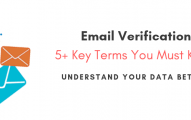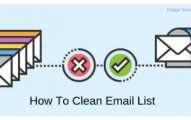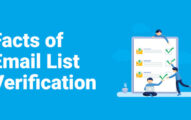Your target audience doesn’t want you to pay attention. They want you to earn their attention instead. Learn about Successful Guide To 4 L’s of a Lead Generation Strategy.
Lead generation strategies must be revised across the sector to better meet the demands of the target markets.
The initial step is to develop appealing content. The second step is to utilize the content to convert viewers to leads. Of course, it’s easier to do than it is said.
To emphasize the importance of a strong lead generation strategy, we’re rewinding the time a bit.
Do you know the metaphor of the teacher who challenged his class with the task of putting pebbles, rocks, water, and Sand into a container as quickly as possible?
Prioritizing the most important items and placing them into the container first allowed him to maximize the space utilized. Your company should adopt the same approach when incorporating today’s lead generation strategies into your inbound marketing strategy.
We’re ListCleaningAdvice, the best email validator services listers in the world, and utilizing our knowledge and experience, today we present you the “4L’s formula.”
The Rocks, pebbles, water, and Sand are the Inbound Marketing elements
As the professor who challenged his students to put these 4 elements into the jar, your outbound marketing strategy will consist of pebbles, rocks, and Sand. This is what I mean by that:
- What are the major stones that are most important to your strategy?
- Which are pebbles that act as additional, helpful instruments for your company?
- What little things or distractions do you have in the business sand?
The majority of businesses would say that their customers serve as their “rocks” However, we’ve got a different idea.
It is undisputed that customers are vital to any company. We’d like to imagine their importance as the source of water utilized to eventually fill the container. The water was poured only after all other items were tightly packed into the container.
Your business could benefit from incorporating this mentality into your inbound marketing strategy.
The Four L’s of the Lead Generation Strategy
Your content is the rock you are using. Making sure you fill your jar with compelling content plays an important role in your lead generation. This is true for the tools you use to attract traffic, including your blog SEO, PPC, and social platforms.
Around 90% of business-to-business customers require information from thought leaders in the industry to guide their purchasing choices. Producing compelling content is your primary goal to establish your reputation as an authority professional in your field.
You’ve heard that you are able to catch lots of flies using honey, but it is also possible to get more honey to flow. You can try that cliche at the bar, and it could result in a drink being thrown at you. However, incorporating that mentality into your inbound marketing strategy can not only boost lead generation rates but also boost the number of qualified leads that your business can draw.
We’ve put our rocks (that are our content) in position. This article will concentrate on the next step after that — the pebbles (the best methods to get leads from your content).
You’ll quickly see why businesses that have jumped on the train of content are creating more leads in a month than those that do not. Let’s look at what the 4 L’s are of lead generation.
Lead Capture
The odds are that 50% of your users are unlikely to return to your website. Suppose you don’t collect some information from them. A valid mail address can be the most important item a marketer can get here, but users are not always eager to provide this type of private information to you.
The call-to-action (CTA) buttons such as “Sign up Here” have become synonymous with “We will Spam You,” which is why marketers have to come up with new ways to collect the information they need.
Nicholas Kusmich, a Facebook Ads Specialist and Strategic Marketing Consultant, proposes a brand new method of collecting information about visitors. Kusmich suggests two golden rules to take into consideration:
- We must be generous before we request it.
- Every stage of this process (advertisements or promotions) should be worth it by the process.
Kusmich is more in-depth about the concepts in his article “2 Gold Rules for the new Era of Marketing,” but let’s just focus on the first one.
Do you think there was an age, not too long ago, when the opt-in box for email was an indulgence?
It was a guarantee that all the information you needed was delivered in the comfort of your home. “What an exciting time to be alive!” – we all believed. The day has gone. Now, we are fighting against information from every angle.
In between the installation of pop-up blockers as well as dumping our junk mail, we took vows to never “Sign up here” ever again.
It’s about the time that marketers begin slowly dismantling the barriers that potential buyers have built with new ways to mutually benefit from opt-in and collect their data. The most effective marketing strategy to use this method of “giving prior to asking” is to use lead magnets.
Lead Magnets
A successful customer lifecycle involves optimizing the process of converting visitors to leads. There is a gap between the initial phase of traffic generation and lead generation that can result in single-time visitors who do not bother with the effort to record their data and never get a response ever again.
You can close that gap with lead magnets. Lead magnets are a tool that offers value to your site visitors as a reward for contact details. Businesses make use of lead magnets, such as subscriptions, email opt-ins, and social media followers, to search for signs of interest on behalf of their site’s customers.
The purpose of this is to obtain permission from the visitors in order to keep them informed. Examples of lead magnets are:
Training video series
- Free trial
- Webinars
- eBooks
- White papers
- Bonus tips
- A conversation with authority on a pertinent subject
These free educational tools make your visitors feel comfortable with your offerings which will allow you to get their email addresses and inform them about your company.
Whatever elements you choose to employ as lead magnets must be listed in your marketing plan and the goals, budgets, or timetables for the creation and distribution of the marketing tools.
Landing Page Conversion Techniques
Another major asset for your company when you are trying to convert leads into visitors is landing pages. This could refer to any page that a user lands upon after clicking advertisements or other online marketing tools. It is crucial to remember that landing pages can be found separately from the website of your business and are typically used as a part of an individual marketing campaign.
To get a quick review of the HubSpot Blog’s lead generation strategies, you can check out our video tutorial.
We’ll cover some of the fundamentals of landing page design that work today, but make sure to take a look in the future for a well-detailed breakdown of the various elements that are involved.
Getting a bit deeper
Landing pages serve two purposes capturing leads as well as warming the potential buyers. Both are crucial elements to help move customers further into the sales funnel. In addition, there are two kinds of landing pages:
Landing pages for lead generation are designed to gather information from a company or user as a reward for something. This is in line with the idea discussed previously, “giving prior to asking.”
Click-through landing pages can be used to draw the user to the product or service you want to promote. The objective is to inform your potential customer and convince them to purchase.
The landing pages on your site just have one goal in your mind. Instead of overwhelming your visitors with details about your company as well as the various products and services that you provide, It is crucial to narrow down the objective in your mind.
Make sure you remove any unnecessary information that’s not important to the promotion. Be sure to provide just one type of form or CTA URL for them to make use of.
The most crucial aspect of your landing page is to fulfill the promise your advertisement source made. If the ad you are running reads “Get 40 percent off computers here,” you must assure that as soon as the user visits your landing page, your promise is fulfilled.
One method to accomplish this is to create the CTA on the ad’s headline from the landing page. Another option is to ensure the font, color, and images you use in your advertisement are replicated in your landing pages to a certain extent.
Lead Scoring
Lead scoring is one of the components of marketing automation software. It assists in determining the best leads based on their degree and engagement levels with marketing content. Now, this can also aid in determining those who are ready to buy. It also helps you find out what they are interested in if set up properly.
This method is utilized to determine the amount of interaction prospective customers experience with your website content by assigning points to different kinds of engagement. A great example of numerous kinds of engagements as well as their points values could be as follows:
- Download an ebook and Add 5 points
- Check out a product overview video 7 points = Add
- A job role that is not a great match: deduct 10 points
- Complete the opt-in form. Add 7 points
- Unsubscribe from a list of subscribers: Deduct 7 points
It’s surprising that 79 percent of B2B marketers had not implemented an approach to scoring leads. Lead scoring provides your business with real-time information on how your leads respond to your marketing campaigns. It could also be a sign of people who are willing to purchase from you but haven’t had contact with you.
This approach based on points to identify and analyze the most popular leads will help your business save time and money in reaching your targeted market and making the most of sales opportunities. Once you have identified your top leads, you can now contact them confidently as they are engaged and aware of your company.
Conclusion
Lead generation is an integral part of every company’s marketing plan. Consider how many businesses you’ve been to since the beginning of the internet and have never returned to. They did not just catch your attention at that moment, but they also failed to get back in touch with you in the near future.
This is the result of failing to grasp the lesson by the analogy of prioritizing the various elements of your marketing plan so that you have a solid foundation there to create an effective and efficient strategy.
Once you have your content up and running and your company’s content in place, you can begin with lead magnets as well as lead capture, an interesting landing page design, as well as lead scoring to improve lead generation and develop an overall more efficient an inbound marketing plan.


